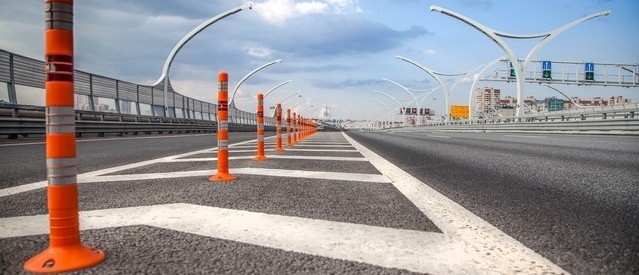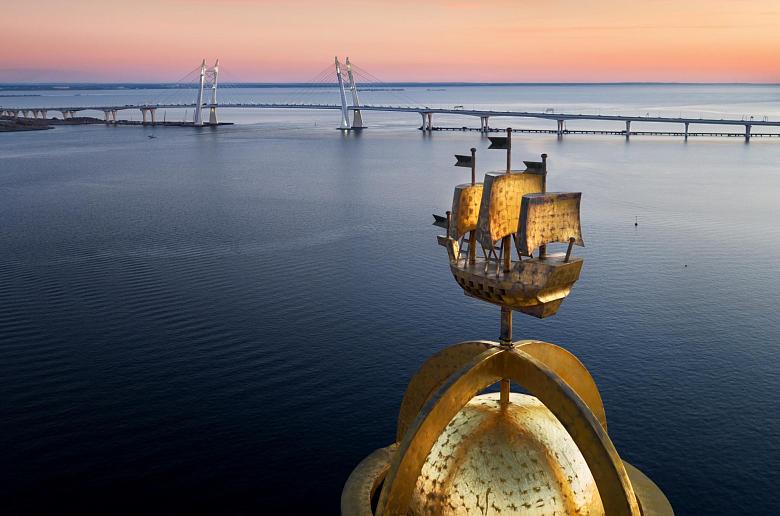
The Construction of the Central Section of the Western High-Speed Diameter Highway is simultaneously ongoing at nine locations and at some of them ahead of the Schedule. According to experts this section of the motorway is the most complicated one: it will traverse above water and under the ground and will be comprised of unique engineering works: bridges, flyovers, tunnels.
We asked Alan Platt, Executive Project Director of the Northern Capital Highway consortium, to tell us about the peculiarities of the large-scale construction arrangement and the progress of works.
-Mr. Platt, every facility comprising the Central Section of the highway is a highly complicated transportation facility in terms of the engineering. Probably, organization of the construction process is no less complicated…
-The project is really quite unusual, unconventional; I would even say a unique one. The Central Section of the WHSD, as is known, will run from the Ekateringofka Embankment to the interchange with the Promorskoye Shosse, crossing the water areas of 11,7 km on its way, such as the Sea Channel, Korabelny, Petrovsky and Elaginsky fairways, the stream channel of the Smolenka river.
Such route, certainly, assumes construction of bridges, flyovers, tunnels. As a matter of fact, almost the entire section of the highway will be consisting of artificial engineering structures. These are the three crossings: two-level steel viaduct, two cable stayed bridges. I would like to note that the bridge over Korabelny fairway will be the first cable stayed bridge with pylons inclined inwards by 12 degrees. On Vasilievsky Island at the crossing of the highway with the Smolenka river a tunnel will be constructed.
As for organization of construction, everything is being done in accordance with the accepted international practices for construction of the facilities of such an engineering level and complexity. We had enough time from the date when the tender result was announced in August 2011 and until December 2012 when negotiations on deferred conditions were completed and the Public-Private Partnership Agreement between the NCH consortium and the City of St. Petersburg was signed.
We used it to elaborate a construction programme with the partners, to establish the mobilization sites, to construct office centers, construction camps and accommodation spaces, to develop the working documentation and the method statements, that is, to do everything to carry out construction works without failures.
I would like to note with satisfaction, that starting from the first quarter of this year we commenced the wide-range construction works in full compliance with the preliminary approved programme and by the method provided for for organization of such a large-scale and specific construction.
The works are ongoing now at all the nine locations simultaneously - the contractors start work from different directions and move towards each other. At some locations they are ahead of the programme. The tempo set allows to be sure that the construction of the site will be fully completed within the 36 months given.
-What has already been done in this season?
-Engineering and geological surveys are completed, including operations on clearing the entire water area of the explosive objects. Thus, a geodetic base for construction has been created. Construction of piles and foundations on the north of the Section, specifically, at the South of Savushkina Street is nearing completion. Now the construction of temporary flyovers, temporary technological platforms from which the construction of the main carriageway piers will be performed is actively ongoing. The construction of platforms is ongoing on the North and the South of Vasilievsky Island and on Krestovsky island .
I expect the construction of technological platforms in the area of Kanonersky Island, which will go around the Bely Island to ensure access to the water area of the Cable Stayed Bridge construction, to take the most of the time. But, as provided for in the programmed, by the end of the year all the platforms will be constructed at the locations identified in the design.
It is a very important stage of the project implementation: technological platforms and flyovers will be used by the contractors as operations support facilities: steel structure assembly sites will located here, trucks to deliver construction materials will be moving in both directions.
-In such large-scale construction project a great number of contractors, suppliers of equipment and construction materials are involved. How are they coordinated?
-We are involved in a major project which requires constant attention. In order to manage the project with the required quality, it was divided into individual subprojects. Therefore the consortium Northern Capital Highway and the General Contractor - ICA Astaldi-IC Ictas WHSD Insaat Anonim Sirketi Joint-Stock Company – are both performing the project management.
Undoubtedly, considering that the works are simultaneously ongoing at nine locations, it is not easy to track the activities of all parties involved. We are managing that via software intended for the projects of this nature and scale allowing us to coordinate both the document control and the relationships between the management structures. But the most important thing is that the level of detail of the construction programme developed with all the interested parties is so high that it allows us to daily monitor the works.
-How do you assess the performance of the general contracting company?
-ICA is a joint venture created by merging of two well-known construction companies – an Italian company Astaldi and a Turkish company ICA ICTAS INSAAT. These are successful contractors having implemented major transport projects. They are professionals and each company has its own approach to doing business and to managing the construction. Combination of their experience and their contracting work history give a good result.
-Is selecting subcontractors a zone of the Contractor’s responsibility only?
-It’s a multi-step procedure and the terms for passing thereof are specified in our concession PPP agreement. At the first stage, all the potential participants have to pass prequalification. The protocol is the following: the general contractor submits the package of documents on a potential subcontractor to the specialists of the consortium. We make an overall assessment of the company, its potential, reputation. Then the package is submitted to our partner – Western High-Speed Diamter OJSC- who is representing the interests of the City of St.Peteraburg.
The City, more specifically, the WHSD OJSC specialists provide their recommendations, make additions and amendments. The General Contractor revises the proposals to address all the comments and assessment and resubmits the documents for approval to us and the City. From now on a potential contractor is considered to have passed prequalification and may take part in the tender process for the contract award.
We are not involved in the final negotiations between the selected tender participants. It is the job of the general contractor. But when there are questions with regard to the quality of the works or other criteria, we have a right under the contract to note this and to take actions and even to exclude the company involved in construction from the project.
-Who is supervising the quality of the works performed?
-Three tools are used to manage the quality. In the consortium structure, as well as in the structure of the general contractor, the teams have been created to control compliance with the quality requirements. In addition, we and the City have shared equal expenses and hired an Independent Engineer –a Danish Company Cowi – who is bearing full legal responsibility for the quality of construction works and performs daily control over the subcontractors. It’s a common practice accepted for international investment projects.
-As a rule, untimely financing of the works is one of the major problems in large scale construction projects…
- The reason for the project being attractive for the general contractor and other stakeholders is that the financing part was initially predetermined.
The project cost is known and is firm, the financing partners and the lenders of the consortium are known. There is no need neither for the general contracting company, nor for the subcontractors to search for their own resources or to attract external resources in the period of construction.
Preparing the documents and requests for the money amount required properly is enough. Moreover, under the PPPA Agreement the finance partners and the lenders bear responsibility for not fulfilling their obligations to provide the funds.
-And what was it that attracted you to get involved in this project? How comfortable it is for you to live and work in our city?
-I am very happy to be here. It’s the seventh country I am working in and the seventh project in my life I am involved in. My previous job was in Melbourne, Australia. St. Petersburg project is a more complex one in terms of the scale of business and in terms of the scale of construction, which is even more interesting.
I am happy that I was offered the contract for the construction management, happy to have established professional and honest relationships with the managers of the consortium which is important for achieving the goals I was assigned with.
The only thing lacking is knowledge of the language, but I hope to learn Russian during this period.
And, frankly speaking, nowhere was my spiritual and social life so full and filled with events. I have already visited the marvelous St.Petersburg environs, both stages of Mariinsky Theatre. Moreover, I am glad that St.Petersburg is of great interest to my fellow countrymen and I am constantly having guests from England staying over with whom I share my impressions.
Rosa Mikhailova







